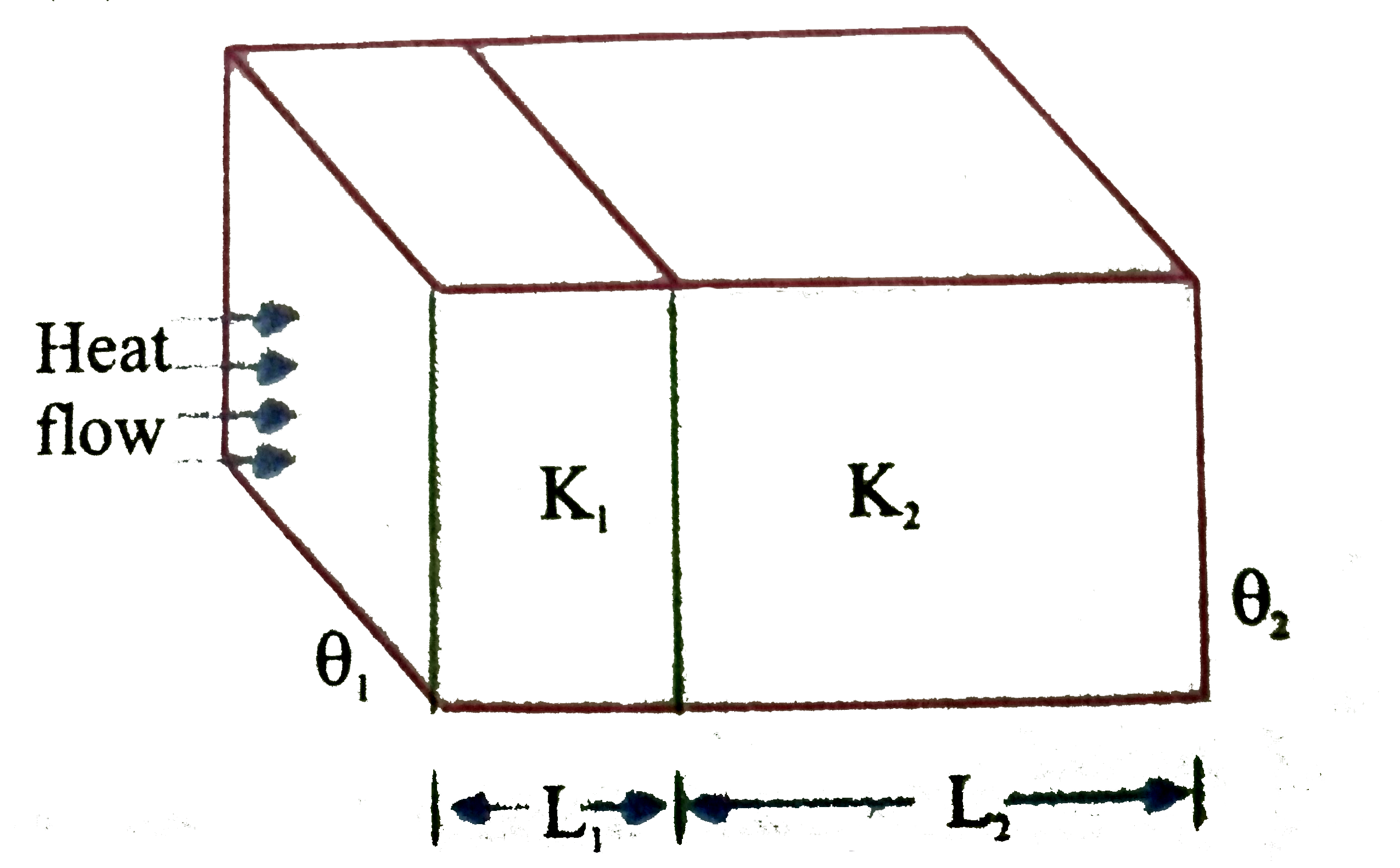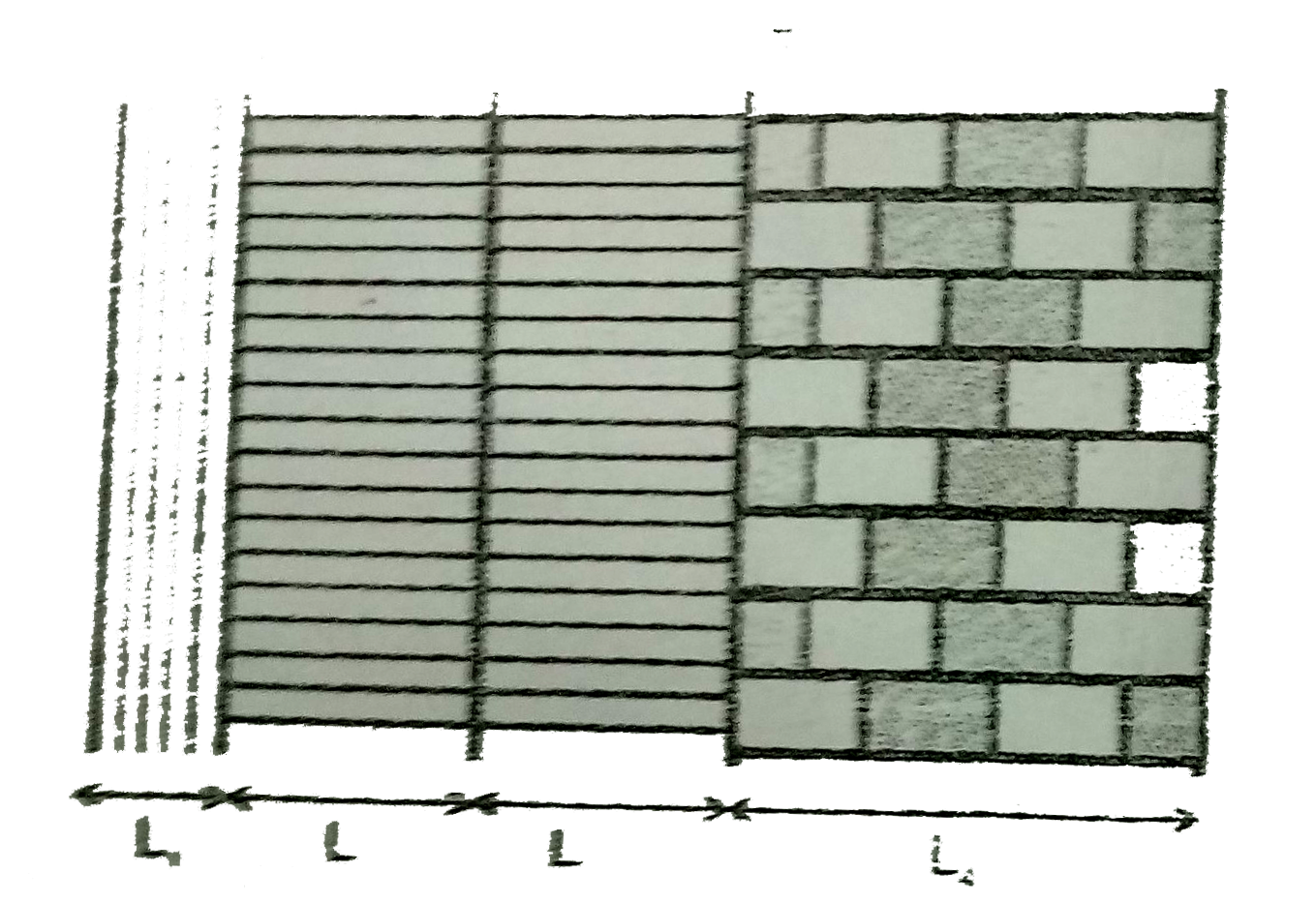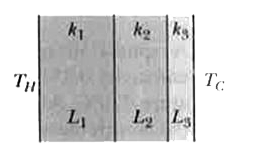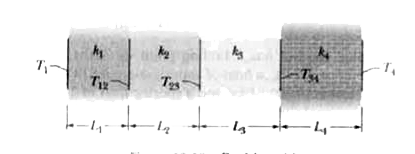Temperature shows in cross section a wall consisting of four layers with thermal conductivities K1=0.06W/mK,K3=0.04W/mK and K4=0.10W/mK the layer thickness are L1=1.5cm,L3=2.8cm and L4=3.5 cm. The temperature of interfaces is as shown in figure energy transfer through the wall is in steady state.
Q. Temperature of outer surface of sphere is
100∘
80∘
48∘
60∘
For spherical surface at steady state
Pheater+50W=120W
⇒PHeater=70W
At steady state PHeater=(100−tout)kAl=70=k'(tout−20) ….(i)
From te given observation
50=k'(40−20)
from equation (ii) k'=52
From equation (i)
tout=48∘
l=0.52mm
Topper's Solved these Questions
Similar Questions
A radioactive element decays by β−emission. A detector records n beta particles in 2s and in next 2s it records 0.75n beta particles. Find mean life correct to nearest whole number. Given ln |2|=0.6931, ln |3|=1.0986.
View SolutionWhen p−n junction diode is forward biased then
View SolutionFigure shows in cross section a wall consisting of four layers with thermal conductivities K_(1) = 0.06 W // mK, K_(3) = 0.04 W// mK and K_(4) = 0.10 W// mK . The layer thickness are L_(1) = 1.5 cm, L_(3) = 2.8 cm and L_(4) = 3.5 cm . The temperature of interfaces is as shown in figure. energy transfer through the wall is in steady state. the temperature of the interface between layer 3 and 4 is:
View SolutionIf layer thickness L2 is 1.4cm, then its thermal conductivity K2 will have value (in W/mK)
View SolutionFigure shows in cros section a wall consisting of four layers with thermal conductivities K_(1)=0.06W//mK K_(3)=0.04W//mK and K_(4)=0.10W//mK . The layer thicknesses are L_(1)=1.5cm,L_(3)=2.8 cm and L_(4)=3.5cm the temperature of interfaces is as shown in figure. energy transfer through the wall is in steady state. Q. The temperature of the inteface between layers 2 and 3 is
View SolutionTemperature shows in cross section a wall consisting of four layers with thermal conductivities K_(1)=0.06W//mK,K_(3)=0.04W//mK and K_(4)=0.10W//mK the layer thickness are L_(1)=1.5cm,L_(3)=2.8cm and L_(4)=3.5 cm. The temperature of interfaces is as shown in figure energy transfer through the wall is in steady state. Q. Electric power of heater is:
View SolutionTemperature shows in cross section a wall consisting of four layers with thermal conductivities K_(1)=0.06W//mK,K_(3)=0.04W//mK and K_(4)=0.10W//mK the layer thickness are L_(1)=1.5cm,L_(3)=2.8cm and L_(4)=3.5 cm. The temperature of interfaces is as shown in figure energy transfer through the wall is in steady state. Q. Thickness of hollow sphere is
View SolutionTwo walls of thicknes l1 and l2 and ther-mal condctivities K1 and K2 are in contact In the steady state, if the temperature at the outer faces are T1 and T2 find the temperature at the common wall .
View SolutionTwo plates each of area A thickness L1 and L2 thermal conductivities K1 and K2 respectively are joined to from a single plate of thickness (L1+L2) If the temperatures of the free surfaces are θ1 and θ2 Calculate
(a) Rate of flow of heat
(b) Temperature of interface
 .
.
View SolutionThe figure shows the cross-section of the outer wall of a house buit in a hill-resort to keep the house insulated from the freezing temperature of outside. The wall consists of teak wood of thickness L1 and brick of thickness (L2=5L1), sandwitching two layers of an unknown material with identical thermal conductivites and thickness. The thermal conductivity of teak wood is K1 and that of brick is (K2=5K). Heat conducion through the wall has reached a steady state with the temperature of three surfaces being known. (T1=25∘C,T2=20∘C and T5=−20∘C). Find the interface temperature T4 and T3.

View SolutionTwo rods of the same area of cross-section, but of length l_(1) and l_(2) and conductivites K_(1) and K_(2) are joined in series. Show that the combination is equivalent of a material of conductivity K = (l_(1)+l_(2))/((l_(1)/(K_(2)))+((l_(2))/(K_(2))))
View Solutionसमान अनुप्रस्थ काट की दो छड़े एक-दूसरे से सटाकर रखी गयी है जिनकी लम्बाइयाँ क्रमश: l1 तथा l2 तथा ऊष्मा चालकताएँ K1 व K2 है | सिद्ध कीजिये कि स्थायी अवस्था में छड़ो के सिरों के तापान्तर का अनुपात K2l1:K1l2 होगा |
View SolutionFigure shows the cross section of a wall made of white pine of thickness L_(a) and brick of thickness L_(d) = = 2.0 L_(a) , sandwiching two layers of unknonw material with identical thicknesses and thermal conductivities. The thermal conductivity of the pine is k_(a) and that of the brick is k_(d) ( = 5.0k_(a)) . The face area A of the wall is unknown. Thermal conduction through the wall has reached the steady state, the only known interface temperatures are T_(1) = 25^(@)C, T_(2) = 20^(@)C , and T_(5 ) = - 10^(@)C . What is interface temperature T_(4) ?
View SolutionFigure shows the cross section of a wall made of three layers. The layer thicknesses are L1,L2=0.750L1, and L3=0.350L1. The thermal conductivities are k1,k2=0.900k1, and k3=0.800k1. The temperature at the left side and right side of the wall are TH=30.0∘C and TC=−15.0∘C, respectively. Thermal conduction is steady . (a) What is the temperature difference ΔT2 across layer 2 ( between the left and right sides of the layer ) ? If k2 were, instead, equal to 1.1k1, (b) would the reate at which energy is conducted through the wall be greater than, less than, or the same as proviously, and (c ) what would be the value of ΔT2 ?

View SolutionFigure shows ( in cross section ) a wall consisting of four layers, with thermal conductivities k1=0.060W/m.K,k3=0.040W/m.K, and k4=0.12W/m.K(k2 is not known). The layer thickness are L1=1.2cm,L3=5.6cm, and L4=4.0cm (L2 is not known ) . The known temperatures are T1=30∘C,T12=25∘C, and T4=−10∘C . Energy transfer through the wall is steady. What is interface temperature T34 ?

View Solution
